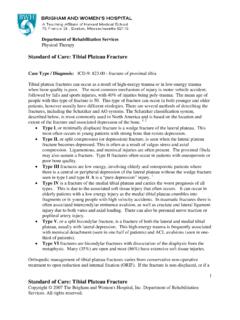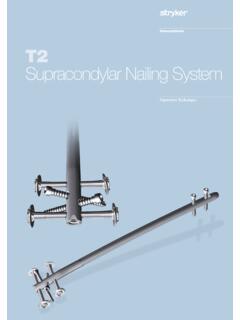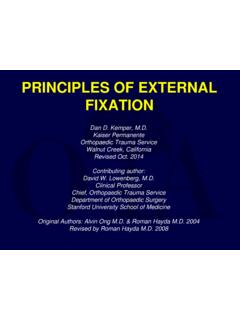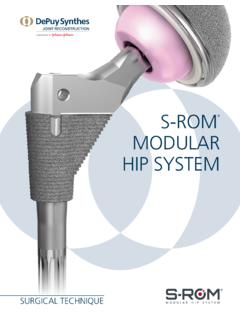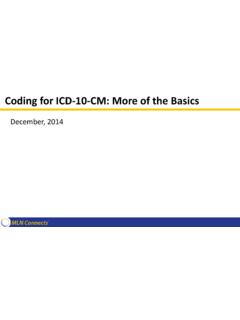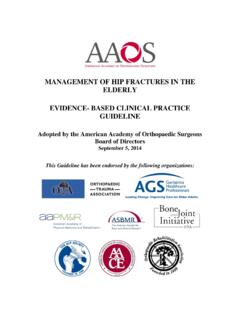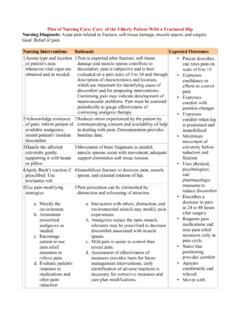Transcription of ICD-10 Coding Basics
1 ICD-10 -CM Structure ICD-9-CM ICD-10 -CM 3- 5 characters First character is numeric or alpha (E or V) Characters 2-5 are numeric Always at least 3 characters Use of decimal after 3 characters 3- 7 characters 3 characters before the decimal and up to 4 characters after the decimal 1st character is alpha (all letters except U are used) 2nd character is numeric Characters 3-7 are alpha or numeric Alpha characters are not case-sensitive ( , Right ankle sprain, initial encounter: , , , ) Similarities to ICD-9-CM Tabular List Chronological list of codes divided into chapters based on body system or condition Same hierarchical structure Chapters in Tabular structured similarly to ICD-9-CM, with minor exceptions A few chapters have been restructured Sense organs (eye and ear)
2 Separated from Nervous System chapter and moved to their own chapters Similarities to ICD-9-CM Index Alphabetical list of terms and their corresponding codes Indented subterms appear under main terms Same structure as ICD-9- CM Alphabetic Index of Diseases and Injuries Alphabetic Index of External Causes Table of Neoplasms Table of Drugs and Chemicals Similarities to ICD-9-CM Many conventions have same meaning Abbreviations, punctuation, symbols, notes such as code first and use additional code Nonspecific codes ( unspecified or not otherwise specified )
3 Are available to use when detailed documentation to support more specific code is not available Similarities to ICD-9-CM Codes are looked up the same way Look up diagnostic terms in Alphabetic Index, then Verify code number in Tabular List Codes are invalid if they are missing an applicable character Similarities to ICD-9-CM ICD-10 -CM Official Guidelines for Coding and Reporting accompany and complement ICD-10 -CM conventions and instructions Adherence to the official Coding guidelines in all healthcare settings is required under the Health Insurance Portability and Accountability Act (HIPAA)
4 Differences from ICD-9-CM Expanded detail and specificity Codes reflect modern medicine and updated medical terminology Laterality (side of the body affected) has been added to relevant codes Expanded use of combination codes Certain conditions and associated common symptoms or manifestations Poisonings and associated external cause Combination Codes Examples Atherosclerotic heart disease of native coronary artery with unstable angina pectoris Type 2 diabetes mellitus with unspecified diabetic retinopathy with macular edema Toxic liver disease with chronic active hepatitis with ascites Crohn s disease of small intestine with intestinal obstruction Differences
5 From ICD-9-CM In Tabular, injuries grouped by anatomical site rather than type of injury ICD-9-CM Fractures (800-829) Dislocations (830-839) Sprains and strains (840-848) ICD-10 -CM Injuries to the head (S00-S09) Injuries to the neck (S10-S19) Injuries to the thorax (S20-S29) Addition of 7th Character 7th character used in certain chapters ( , Musculoskeletal, Obstetrics, Injuries, External Causes) Different meaning depending on section where it is being used Must always be used in the 7th character position When 7th character applies, codes missing 7th character are invalid 7th Character Describing Encounter Initial encounter: As long as patient is receiving active treatment for the condition.
6 Examples of active treatment are: surgical treatment, emergency department encounter, and evaluation and treatment by a new physician. Subsequent encounter: After patient has received active treatment of the condition and is receiving routine care for the condition during the healing or recovery phase. Examples of subsequent care are: cast change or removal, removal of external or internal fixation device, medication adjustment, other aftercare and follow up visits following treatment of the injury or condition. Sequela: Complications or conditions that arise as a direct result of a condition ( , scar formation after a burn).
7 Note: For aftercare of injury, assign acute injury code with 7th character for subsequent encounter. 7th Character Fractures A Initial encounter for closed fracture B Initial encounter for open fracture D Subsequent encounter for fracture with routine healing G Subsequent encounter for fracture with delayed healing K Subsequent encounter for fracture with nonunion P Subsequent encounter for fracture with malunion S Sequela Placeholder X Addition of dummy placeholder X (or x ) is used in certain codes to: Allow for future expansion Fill in empty characters when a code contains fewer than 6 characters and a 7th character applies X is not case-sensitive or Adverse effect of calcium-channel blockers, initial encounter or Foreign body in cornea, left eye, subsequent encounter When the placeholder character applies.
8 It must be used in order for the code to be valid Excludes Notes Excludes1 note Indicates that code identified in the note and code where the note appears cannot be reported together because the 2 conditions cannot occur together Example: E10 Type 1 Diabetes mellitus Excludes1: diabetes mellitus due to underlying condition ( ) drug or chemical induced diabetes mellitus ( ) gestational diabetes ( ) hyperglycemia NOS ( ) neonatal diabetes mellitus ( ) postpancreatectomy diabetes mellitus ( ) postprocedural diabetes mellitus ( ) secondary diabetes mellitus NEC ( ) type 2 diabetes mellitus ( )
9 Excludes Notes Excludes2 note Indicates that condition identified in the note is not part of the condition represented by the code where the note appears, so both codes may be reported together if the patient has both conditions Example: L89 Pressure ulcer Excludes2: decubitus (trophic) ulcer of cervix (uteri) (N86) diabetic ulcers ( , , , , , , , , , ) non-pressure chronic ulcer of skin ( ) skin infections (L00-L08) varicose ulcer ( , ) ICD-10 -CM Specificity Examples Increased specificity Nondisplaced fracture of base of neck of right femur, subsequent encounter for closed fracture with delayed healing Sequelae of cerebral infarction.
10 Hemiplegia and hemiparesis following cerebral infarction affecting right dominant side Encounter for orthopedic aftercare following surgical amputation Encounter for aftercare following heart transplant ICD-10 -CM Laterality Examples Laterality Malignant neoplasm of lower-outer quadrant of right female breast Allergic dermatitis of right upper eyelid Pressure ulcer of left hip, stage 3 ICD-10 -CM Coding Examples Type 1 diabetes mellitus with diabetic nephropathy Step 1 Look up term in Alphabetic Index: Diabetes, diabetic (mellitus) (sugar) type 1 with nephropathy ICD-10 -CM Coding Examples Type I diabetes mellitus with diabetic nephropathy Step 2 Verify code in Tabular.











